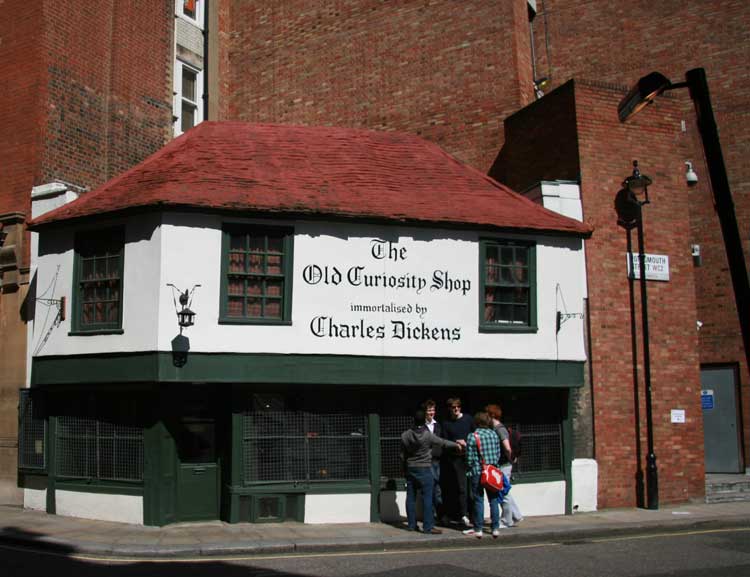
It makes for a delightful flight of fancy to stand outside the old red-tile-roofed structure at 13 and 14, Portsmouth Street, and imagine Charles Dickens standing outside it picturing the virtuous teenage orphan, Nell Trent ("Little Nell") and her grandfather residing within the whitewashed walls of The Old Curiosity Shop.
But, just like the novel from which it takes its name, this flight of fancy must be consigned to the realm of fiction, for, despite the claim boldly emblazoned on the building's facade "Immortalised By Charles Dickens", there is no doubt that Dickens himself had another location in mind when writing The Old Curiosity Shop between 1840 and 1841.
Indeed, Dickens's sister-in-law, Georgina Hogarth (1827 - 1917), told the actor Sir John Hare (1844 - 1921) that the shop that Dickens himself had in mind was located in Green Street (now Irving Street) behind the National Portrait Gallery.
And, if you won't believe his sister-in-law, then why not take it from no less an authority than Dickens himself, who tells us at the very end of the story that, after Kit Nubbles had married Barbara, and had several children, Jacob, Abel, Dick, and little Barbara, he used to take them to the street where his good Miss Nell had lived:-
"But new improvements had altered it so much, it was not like the same. The old house had been long ago pulled down, and a fine broad road was in its place. At first, he would draw with a stick a square upon the ground, to show them where it used to stand. But he soon became uncertain of the spot, and could only say it was thereabouts, he thought, and that these alterations were confusing."
Pretty compelling evidence, I should say, that Dickens had another place in mind when he wrote of his Old Curiosity Shop that:-
"The place...was one of those receptacles for old and curious things which seem to crouch in odd corners of this town and to hide their musty treasures from the public eye in jealousy and distrust..."
However, there can be little doubt that the building in Portsmouth Street is an old one; and those who take the trouble to peruse its exterior will even see the date 1567 painted onto one of its exterior beams.
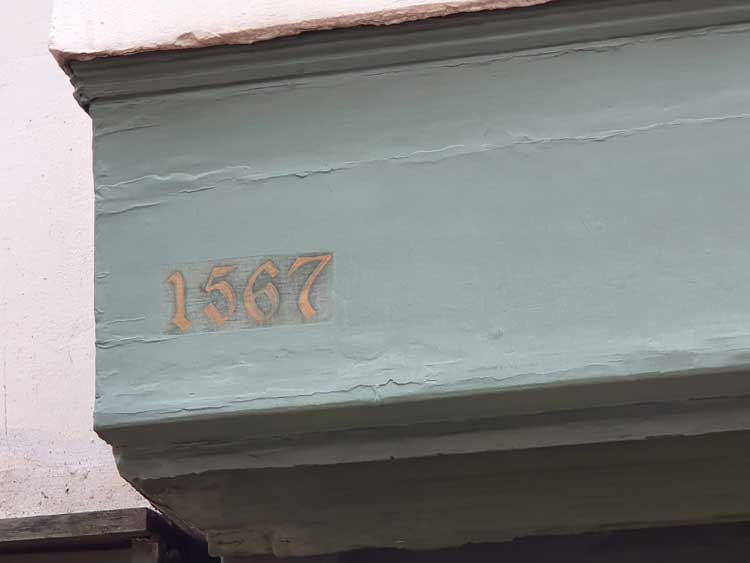
Indeed, it is so old that it is now a listed building and is widely considered to be London's oldest shop, despite there being no evidence of its actually having been a shop prior to the Victorian era.
And one thing that becomes more than apparent when studying the building's history is that it is a true miracle that the building has survived the march of time and progress, given that, at various times in its long existence, there have been numerous occasions when its imminent demise has been announced and it has come within a hair's breadth of being demolished.
The other thing that becomes apparent, whilst perusing the many photographs of the building at the various stages of its existence - well, as far back as the 1880s - is that, at some stage in its illustrious history The Old Curiosity Shop went from being immortalized by Charles Dickens to being immortalised by him.
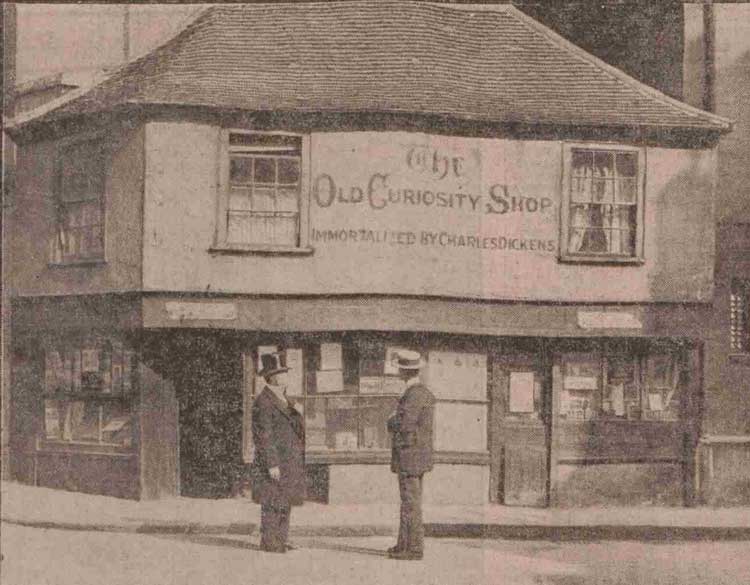
The Old Curiosity Shop in 1910.
The man in the top hat was Charles Dickens's son, Alfred Tennyson Dickens.
From The Dundee Evening Telegraph, Thursday, 29th September, 1910.
Copyright, The British Library Board.
The general consensus is that the buildings now known as "The Old Curiosity Shop" were built in the 1500s as two tiny dwellings. The land on which they stood was later gifted to Charles II's mistress, Louise de Kérouaille, Duchess of Portsmouth (1649 - 1734), for whom Portsmouth Street is named, and the two tiny dwellings were knocked into one larger dwelling and turned into a dairy.
Like many of London's historic buildings, The Old Curiosity Shop is reputed to have been constructed from the timbers of old ships - a claim that has me wondering how we British ever managed to achieve our status as a major sea power, given that it appears that we were forever turning all our ships into old buildings.
It is uncertain what use the building was put to throughout the 18th century, but it became a bookbinder's shop at some stage in the mid 19th century.
Quite what use it was being put to when Dickens was roaming the area composing the plot of The Old Curiosity Shop is unknown, but there can be little doubt that Dickens would have known the premises, since his great friend, John Forster, lived nearby at number 58 Lincoln's Inn Fields.
So, when exactly did this old building become associated with the Dickens novel with which it shares its name?
Well, the first mentions of the Portsmouth Street premises as "The Old Curiosity Shop" date from the 1880s, although the claim of its connection to Dickens's novel had already been established by this time.
In 1883, a Mr. Charles Tesseyman wrote a letter to The Echo claiming that his brother - "a dealer in books, paintings, old china etc.," - who had occupied the premises from 1868 to 1877 had added the words "The Old Curiosity Shop" to the facade of the shop-front, "for purely business purposes." He went on to say that:-
"...no suggestion had ever been made that the place was the veritable Old Curiosity Shop immortalised by Dickens.
After my brother's death in 1877, the present tenant had my brother's name painted out, but left standing the words "The Old Curiosity Shop" - doubtless with a shrewd eye to business.
An American writer, visiting the house, I think in 1881, and seeing the inscription had his imagination fired with thoughts of Little Nell and Kit, and Dick Swiveller and Quilp, and straightaway wrote an article in Scribner's Monthly, in which he assured his readers that this was the old original Old Curiosity Shop of Dickens."
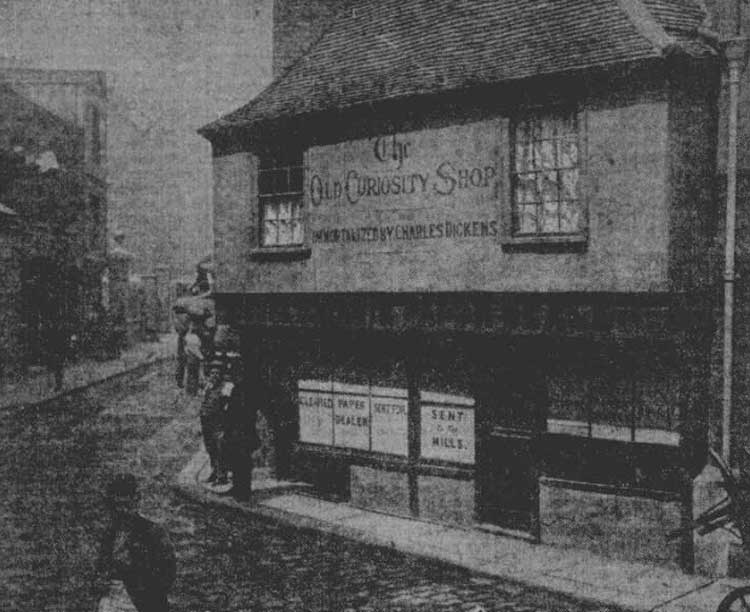
It would appear, therefore, that the deception that the shop in Portsmouth Street is the actual Old Curiosity Shop of Charles Dickens repute was begun by Mr. Tesseyman.
Interestingly, if the following article, which appeared in The Illustrated London News on Saturday, 5th January, 1884, is to be believed, Charles Dickens had, in fact, visited the shop during Tesseyman's tenure:-
"Portsmouth-street, the crooked thoroughfare at the south-east corner of Lincoln's Inn Fields, leading to King's College Hospital, wedged into a small angular nook between taller buildings, is a queer little cottage, which is now occupied Mr. H. Poole, a waste-paper dealer, who uses it for his store and shop, and not for a dwelling; but remember that, only three years ago, there was a diminutive bookshop and print-shop, kept by a shrewd old fellow named Tesseyman, who had removed hither from one of the courts or alleys near Drury-lane, and who lived here with his wife.
Tesseyman was something of a humourist, and had in his time been personally acquainted with many theatrical and literary celebrities of the past generation.
The late Mr John Forster was one of his patrons, and brought Charles Dickens, with other friends who had a taste for quaint reminiscences of old London life, or who cared for chance purchases of old play-bills, broadsheets, caricature drawings, and autographs, to visit the odd little shop.
But though a few cheap relics of antiquarian interest, more especially the autograph letters of famous actors, and engravings of portraits, might sometimes be got here, Tesseyman's whole store of books was never worth five shillings altogether; it was the shabbiest collection of insignificant odd volumes, in the raggedest and dirtiest condition, to be found all over London.
When he had sold the better part of his small stock in trade, he fell into helpless poverty; and we are sorry to learn that he died in the workhouse, and his wife is also dead..."
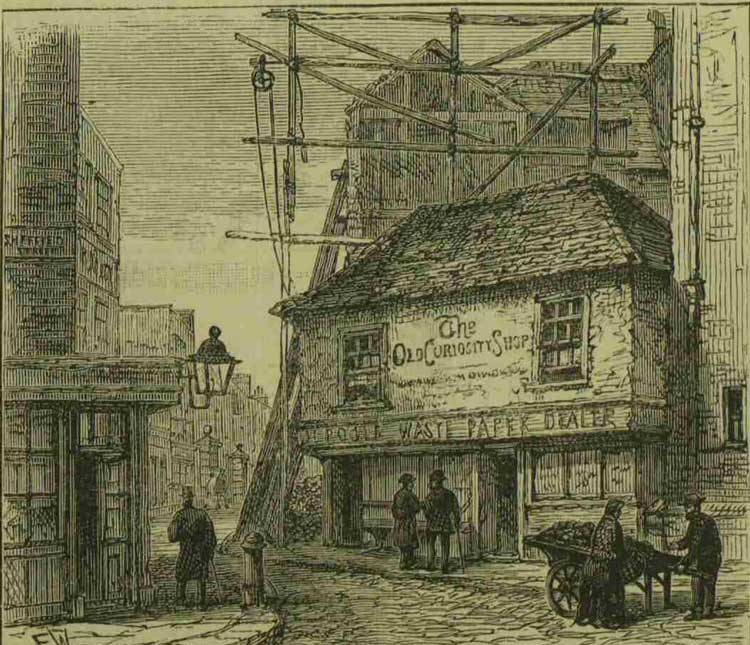
The Old Curiosity Shop in 1884.
At some stage in the late 1870's or the early 1880's, the premises was taken over by Mr. H. Poole, a waste paper dealer, who used it for his store and shop, and not as a dwelling.
At first, Poole doesn't appear to have made too much of his building's "Dickensian associations", and the shop doesn't appear to have attracted any widespread attention.
But then, at Christmas, 1883, it was announced that the shop was about to be demolished, and, working on the premise that you don't know what you've got until it's gone - or, in this case about to be gone - suddenly, everybody wanted to pay a visit to Portsmouth Street to take a look at the about to be no more relic of Dickensian London that had not been immortalised by Charles Dickens!
The St James's Gazette reported on the renewed interest in the shop in its edition of Friday, 28th December, 1883:-
"The old house selected by Charles Dickens as the scene of many of the incidents recorded in "The Old Curiosity Shop" is about to be demolished, in consequence of its dangerous condition.
The house is No. 14, Portsmouth-street, Lincoln's-inn-fields.
Information reached the Metropolitan Board of Works late on Christmas Eve that the "old curiosity shop" and the two adjoining houses were collapsing. The contractors to the Board were immediately instructed to shore the houses up, and during Christmas Day were busily engaged in doing so.
On Boxing Day, many visitors went to the spot, among them being several Americans, who appeared to take a lively interest in all that was being done, and were most anxious to have a peep inside the old shop.
The premises appear to be used as a store for waste paper, the adjoining houses being let out in tenements."
The Dundee Courier, on Saturday, 29th December, 1883, questioned the property's authenticity as a Dickensian location:-
"Whatever a great artist touches he consecrates. Charts Dickens was a great artist, and, he laid the majority of his plots in London and its suburbs, the popular fancy, sometimes directed by commercial enterprises, is often directed to certain spots and as the scenes from which he derived his inspiration. In a few instances we know from his correspondence the true locus; all the rest is left to conjecture, aided by imagination.
Today, we were informed that the "Old Curiosity Shop", from which Little Nell emerges, is No. 14 Portsmouth Street, Lincoln's Inn Fields, which is about to be demolished, and throughout the whole day the building has been visited by sightseers, most anxious to inspect the building, and carry away, if possible, some souvenir.
It is quite possible that the house in question furnished Dickens with a locale because it is old, but, so far as I can discover, there is nothing reliable on which to found the theory.
I have known the house for many years.
Formerly it was a second-hand bookshop, devoted principally to old prints and dramatic literature.
It changed hands several times, and last became a depot for the purchase of waste paper and old parchments, and the last enterprising tenant caused to be painted on the stuccoed front the words, "The Old Curiosity Shop immortalised by Charles Dickens."
Old habitués of Lincoln's Inn Fields admired the ingenuity of the man whilst they laughed at his suggestion.
Unfortunately, for the respectability of the locus, a tenant some year or so ago fell into the hands of the police for purchasing valuable deeds, which had been stolen, as old parchment, and then the legend about the house being the original Charles Dickens' "Old Curiosity Shop" obtained currency."
The Yorkshire Post and Leeds Intelligencer on Monday, 31st December 1883, whilst also questioning its Dickensian authenticity, provided its readers with a description of it nonetheless:-
"Passing through Lincoln's Inn Fields on Saturday, I turned down Portsmouth Street, where preparations are being made for the demolition of the "Old Curiosity Shop," made famous by Dickens's work.
It is a dingy little place, thrust, as it were, into an angle between two houses, and though various placards announced that "business is carried on as usual during alterations," and "all private papers sent to the mill," the shop is doomed.
Artists were busy sketching its humble front and its tiled roof and queer gables. It is no longer a curiosity shop, but a receptacle for waste paper.
Indeed, it is an open question whether it is the house that Dickens wrote about, though "The Old Curiosity Shop immortalised Dickens" is conspicuously printed on its front. No other place, however, claims the honour, and the Portsmouth Street shop will, therefore, be likely to claim it till the end, which, judging from the preparations going on for its removal, will not be long."
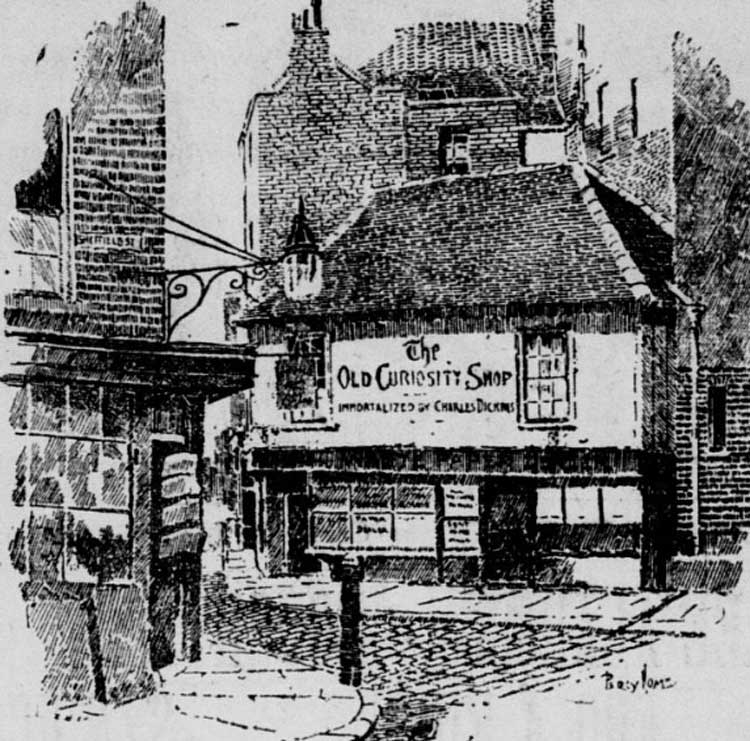
The Pall Mall Gazette, on Tuesday, 1st January, 1884, treated its readers to a peek inside the property, and revealed the identities of some of those who had ducked inside the low-beamed door to bid tearful farewells to the sham shrine, amongst them the American actress Mary Anderson (1859 - 1940), who at the time was appearing at the nearby Lyceum Theatre in Pygmalion and Galatea , and who, so the article claimed, was quite smitten with the tiny little shop:-
"I'm gettin' heartily sick on't", exclaimed the lady of the house, a genial, pleasant soul, with humour in her eye, to our representative yesterday, when he called upon her to ask permission to explore No 14, Portsmouth-street. And not. without reason, indeed; for since Christmas Day the house and the street where it stands have been crowded with visitors and sightseers.
"And one well-dressed person," said my hostess, with a sniff of contempt, "asked me if he might take a brick away with him as a relic. "I will smooth it down, and it shall be an heirloom in my family forever." A lunatic, I call him. And who knows but he beats his wife?"" But this gentleman, brimming over with sentiment, walked off with the brick under his coat nevertheless.
Many artists have visited the spot since Christmas Day, and many sketches from every point of the compass have been taken.
Yesterday, in the short space of half an hour, a photographer blocked up Sheffield-street with his camera, three reporters were busy taking notes, and two other gentlemen were hard at work sketching the ruins, much to the amusement of the odd fish who constitute the "neighbourhood."
Even during the few minutes I spent in the upper regions of No. 14, one lady (of a certain age) came up the creaking steps, peered. in, apologized for the intrusion, viewed the chaos, remarked that it was a pity, and descended. "I come from Boston," I heard her murmur.
It may be said that a roaring trade is being done in little pictures of the exterior, which may be had for "2d. plain" and "4d. coloured."
Miss Anderson is a constant visitor (so I was told), and insists upon drinking a dish of tea in the parlour when the parlour is once more cosy and rejuvenated. "A charming young lady, and so affable."
"The Old Curiosity Shop" stands in the south-western corner of Lincoln's-inn-fields, and occupies an angle of Portsmouth-street, one window looking north-west, the other two facing Sheffield-street.

The Old Curiosity Shop in 1884.
The red tiles and the overhanging roof have a quaint, old-fashioned air about them, and afford a pleasant relief from the hideous yellow plaster on which is painted, in great vulgar letters, the name with which it 'has been endowed. "Immortalised by Dickens," and just below, in unholy contrast, "H. Poole, Waste Paper Dealer", some rag collector who will get such an advertisement as many a pushing politician would give his eyes for.
Heavy joists give the house support now, and the yawning gap overhead shows the ruined mass of bricks and mortar covered with scaffold poles. Half the construction has tumbled in, the other half remains intact.
At present the house, which is said to be 300 years old, contains four rooms - two on the ground floor and two above them, each pair being divided by a thin wooden partition, two narrow winding staircases forming the means of communication from one floor to the other.
The lower room now left opens on to the street, and may best be described as a small space enclosed by numerous angles. Heavy sloping beams jut out from the low ceiling, the window of ancient make, the fireplace stands in one corner, in another a thin slit of a door opens on to the yard at the back where the waste paper business is conducted.
A little window made in the wooden partition looks into the other room, which is now black chaos, the theory being that these two were once united, and here was stored that marvellous collection, the suits of mail, the fantastic carvings, the rusty weapons, the figures in china, wood, iron, and ivory, the tapestry and strange furniture.
Mounting the crooked staircase a few steps take one to Little Nell's reputed bedroom, a dismal, gruesome apartment about 9 ft. square and as many in height.
One little window lets in what passes for light in Portsmouth-street, which serves only to reveal the gloominess of the surroundings. This is used as a bedroom by the occupants of the house, but at present it has the appearance of a receptacle for lumber. Most of the space is occupied by an ordinary iron bedstead, on which were a few dusty pictures, a meat-cover, and a doormat. A few chairs are on the floor, a few engravings and a plaster plaque of Dickens adorn the walls. The floor is thick with the dust from the ruins, and here and there are a few old hangings, odd bits of carpet, and some empty bottles. The fireplace is stone, painted black, and on the mantel-shelf is a model of a ship under a glass cover. In one corner is a quaint old cupboard.
A portion of this little chamber is cut off by the top of the staircase, which is supposed to gain some light from a window covered with a heavy coat of yellow paint. Below this are fixed some shelves, where a few bundles of musty papers and old books lie neglected and forgotten.
One lingers for a moment at the door, endeavouring to conjure up a vision of the most beautiful of Dickens's creations, but one conjures in vain, Little Nell refuses to appear.
Looking through a little window, a foot square, one sees the ruin in the next room, where the full shock has been felt, where now a mass of rubbish is strewn on the floor.
The controversy rages meanwhile with unabated vigour. But when all is said we fear the "Old Curiosity Shop" at No. 14, Portsmouth-street, is a sham. We have ventured to ask Miss Hogarth for any information respecting the house, but the locality was unfortunately never pointed out to her, and she is unable to speak authoritatively. "My impression is," she writes, "that the identifying of this particular house is a mistake; but I always imagined the place to be more remote. I do not suppose that any one lives now who could throw any light on the matter. Mr. Forster might have known, and George Cattermole and Hablot Browne, certainly."
It is pointed out that in the original edition of "Master Humphrey's Clock," Cattermole, who drew the picture of the interior in "The Old Curiosity Shop,"; showed the house with a step and a spacious portico "reaching nearly as high as No. 14 does in its entirety." And further, "at the conclusion of the story, Dickens wrote that Kit sometimes took his children to the street where Nell had lived, but new improvements had altered it so much it was not like the same. The old house had been long ago pulled down, and a fine broad road was in its place."
And again, Mr. Charles Tesseyman says that his brother occupied No. 14 between 1868 and 1877, and had the words "The Old Curiosity Shop" placed over the front "for purely business purposes, as likely to attract custom to his shop, he being a dealer in books, paintings, old china, and so on. Before that - that is, before my brother had the words put up - no suggestion had ever been made that the place was the veritable house that Dickens immortalized."
All this excitement about what is really a very small matter is indeed a handsome tribute to the genius of Dickens. But the great novelist himself would have been the first to deprecate the storm of sentiment which is raging about this poor tumbledown tenement.
The cynic may well smile softly to himself at these sham tears which are being shed in such profusion over the memory of Little Nell. For he need but go a score of yards away to find himself amidst the hideous shambles of Clare Market. There is revealed a network of black and sombre slums, upon which the sun never shines but to lighten up with a few dim rays the festering heaps of rubbish.
North, south, east, west, in a circumscribed area run these grim and tortuous things called by courtesy streets. Here may be seen tottering, ramshackle houses, and projecting eaves, any one of which might with as great a degree of probability be selected as a competitor in the "Old Curiosity Shop." Here are old shops with their cracked, dusty windows and repellent interiors, blocked up with what it is the custom to call bric-á-brac.
And here may be seen men, women, and children who would gladly sit as models of low life to the next novelist in search of a character.
But "The Old Curiosity Shop" is doomed. At some not very remote period the traffic will be rolling over its site and London will know it no more.
Once on a time a model of Shakespeare's house was built at the Crystal Palace for the edification of visitors. The Americans came and begged for it, imitation as it was. Here is a suggestion. Let those American admirers who come to worship at this Portsmouth-street Mecca start a subscription, and transport No.14, - bag and baggage, beams and bricks - bodily to New York, and set it up there in Madison-square.
Or, better still; the great Barnum is always open to a bargain. His agent, Mr. Davis, is now in town. Let him buy it. Apparently the investment would be profitable, and the pilgrims would be none the less devout because the shrine lay at their own doors."
The Liverpool Echo, on Thursday, 10th January, 1884, provided its readers with an idea of what sort of people were visiting the shop to view it before it disappeared, whilst also giving an intriguing insight into the emotional reactions of many of the visitors:-
"There have been quite pilgrimages to the house in Portsmouth-street that has been wrongly identified with Dickens's Old Curiosity Shop. For the last few years it has been veritable Mecca for all American tourists.
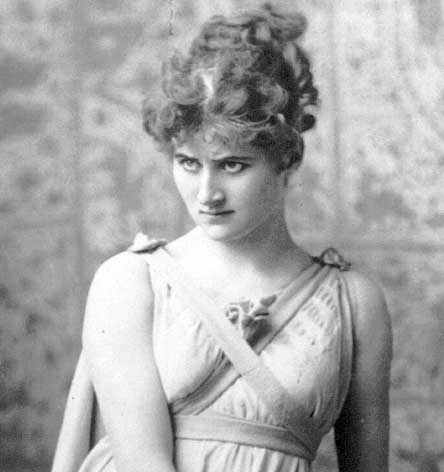
The actress Mary Anderson.
As a resident in the neighbourhood put it, "they went there to worship, taking off their hats when they got through the doorway, and asked questions about Little Nell, Grandfather, Quilp, etc. as if they had been real persons.
The ladies were the worst. I have known them get down on their knees, and burst out crying about Little Nell."
Miss Mary Anderson, the gifted and beautiful American actress, now playing at the Lyceum, visited the spot, and showed genuine emotion looking over the supposed home of Nell with all the pathetic reminiscences attached thereto.
The proprietor of the tumble-down house received a carte-blanche to enter the Lyceum so long as Miss Anderson retains possession the stage..."
The reports of the imminent demise of the Dickensian landmark were, so it turned out, somewhat premature, and the old building managed to survive the threat to its existence.
Mr. Poole, however, appears to have realised that linking his premises to Charles Dickens and boldly claiming that the author had "immortalised" his shop was an extremely profitable enterprise, no matter how tenuous - or, for that matter, untrue - the claim was; and from January, 1885, he began advertising regularly in The Public Ledger And Daily Advertiser, and, as can be seen from the following advert, which appeared on Saturday, December 23rd 1893, he claimed to have been located at the premises for the "last sixteen years", which would make the year of his arrival 1877.
From the outset his adverts made the claim that the shop was "The Old Curiosity Shop" of Charles Dickens fame. So, by 1885, he seems to have traded extensively on the building's fake literary connection, and he would continue to do so into the 20th century.
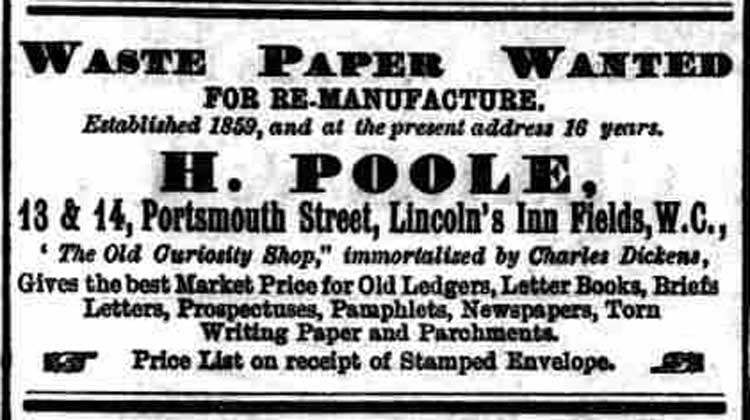
In his seminal study of Dickensian London London And Country Rambles With Charles Dickens, published in 1886, Robert Allbut erred towards the diplomatic on the veracity of the claim that the Portsmouth Street shop was the one immortalised by Dickens:-
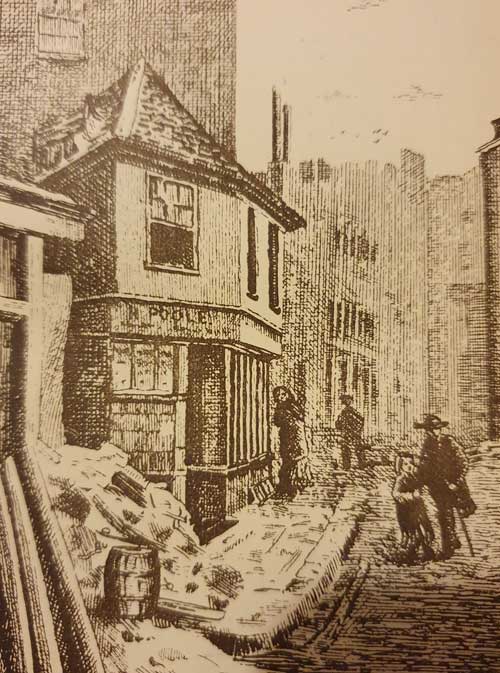
The Old Curiosity Shop in 1886.
"At number 14 will be found (for a short time only) a small old-fashioned house , on the front of which is painted the inscription, "The Old Curiosity Shop Immortalised By Charles Dickens", now occupied by Mr. H. Poole, dealer in waste paper.
This is said to be the home assigned to the novelist for the residence of Little Nell and her Grandfather, with whose pathetic history we are all familiar.
It cannot, however, be regarded as absolutely certain that this particular house was the author' intended "local habitation" for one of the best-known and and loved of his creations.
As these pages are passing through the press, the fiat has gone forth, and preparations are now being made for the demolition of this Old Curiosity Shop as above referred to.
In a few short years, the place that so long has known it, will know it no more..."
However, the stoic old building managed, yet again, to survive this latest threat, and Poole continued to trade on its fictitious reputation as a Dickensian landmark.
But, the more that Poole pushed the notion that his shop had been immortalised by Dickens, the more the newspapers, and those who had known or were related to Dickens, attempted to discredit his claim.
Pearson's Weekly, on Saturday, 7th August 1897, quoted Dickens's son - sadly without revealing which one - on the issue of the little shop's authenticity:-
"The Old Curiosity Shop, in Portsmouth Street Lincoln's Inn Fields, was not "immortalised by Charles Dickens." In the opinion of the novelist's son, "the building is a complete fraud.""
The Luton Times and Advertiser, on Friday, 26th September 1902, treated its readers to Charles Dickens's grandson's opinion on the matter of the shop's authenticity:-
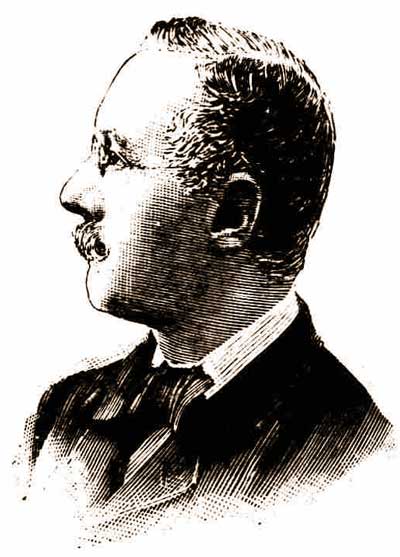
Charles Dickens Jnr (1837 - 1896)
son of the novelist."Mr. Charles W. Dickens, in this month's "Munsey's Magazine," destroys several of the cherished traditions of lovers of Dickens works, for, as a grandson of the great novelist, he speaks with authority.
Among the places which have gained a false sanctity, he says, is the Old Curiosity Shop, in Portsmouth Street, Lincoln's Inn Fields.
He believes that no such shop ever actually existed, although in holding this view he differs from many authoritative critics.
It is worthy of note that in the novel itself, Kit (in his later life) is described as being unable to locate the old house to point it out to his children, and Mr. C. W. Dickens significantly adds, in expressing his opinion, "My authority is one who perhaps knew more about the subject than anyone else - my father, the eldest son of Charles Dickens."
On Friday, 12th July 1907, The Scotsman published the alarming news that the building was again under threat, and warned its readers that they would have to act fast if they wanted to pay a visit to the Portsmouth Street landmark:-
"Improvement schemes have been responsible for the disappearance of many interesting landmarks in London during the past decade.
Another will vanish after the end of the month. This is the "Old Curiosity Shop," in Portsmouth Street, which has been associated with the name of Charles Dickens, though-there is no satisfactory evidence to prove that it was the one immortalised by the great humourist.
The freehold of the shop and other property debouching into Lincoln's Inn Fields has been sold, and on the site a block of business premises will be built.
The shop is a quaint-looking building, dating back to the early days of the reign of James 1st. The second storey, with a frontage of plaster, overhangs the first; and the red-tiled roof slopes at a sharp angle.
On the 31st inst., the trade in Dickens relics will come to an end.
The present tenants, who have found it very lucrative, chiefly from American tourists, have received compensation."
However, like an old maiden aunt who is forever breathing her last, the Old Curiosity Shop appears to have stretched out its imminent demise throughout much of the rest of the year.
On Saturday, November 2nd, 1907, demonstrating typical American forthrightness, The Washington Bee reported that it was still about to be no more:-
"Who knows how much money has been made out of that venerable London fake, "The Old Curiosity Shop," in Lincoln's Inn Fields, with the spurious legend, "Immortalized by Charles Dickens?" It has reaped a rich harvest out of its bogus reputation, but all speculations as to the exact amount would be mere guesswork.
Despite the obvious fact that it is not what it pretends to be, and may in no way resemble the shop of "Little Nell's" grandfather, the old building can truthfully lay claim to upward of 300 years of life.
And while the thousands of enthusiastic Americans who have been in the habit of visiting it every year may have been under a delusion in supposing it to be the identical building described by the great English novelist, nevertheless they had the satisfaction of seeing one of the oldest buildings in this very old city.
But a few weeks hence will see an end of it.
Already, bright red bills are plastered all over the little shop announcing the removal of the waste paper business, which at the present moment occupies the front room, and of the souvenir business which prospers so greatly in the stuffy low-ceilinged room in the rear.
Irrespective of the question of its authenticity, one may sincerely mourn its approaching disappearance, for it is such old places that go far to make the English metropolis so interesting and popular with the American tourist.
Charles Dickens himself disposed of the real Old Curiosity Shop before he finished the book of that name. For, does he not tell us that many years after the death of Little Nell Kit visited the site of the old shop, which had then given place to the march of improvements and was occupied by a broad thoroughfare?
Charles Dickens the younger has also declared that there is no truth in the claim of the building which is now to disappear."
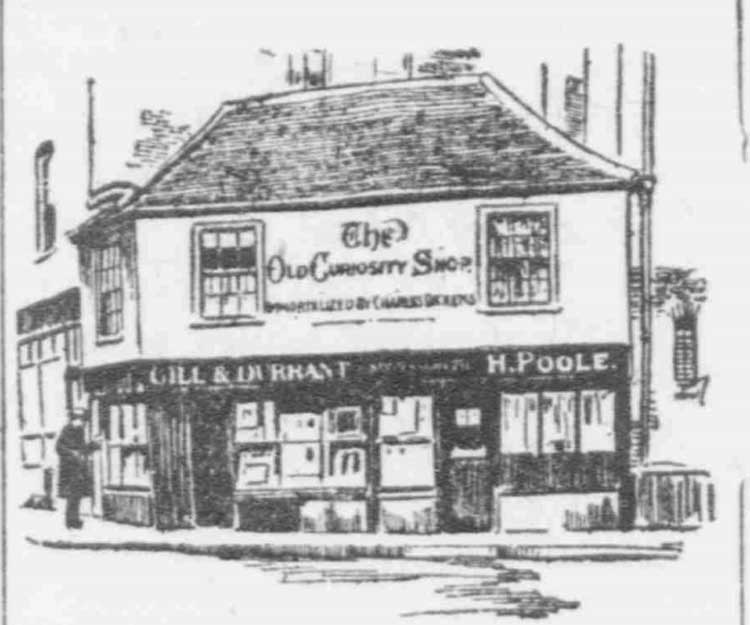
The Sketch of the Old Curiosity Shop in The Washington Bee.
Once again, the old shop managed to repel the assault from the the developers and, as The Nottingham Evening Post reported on Saturday, 16th May 1908, it was put up for sale by auction, albeit it failed to reach its reserve price:-
"Yesterday, at the Mart, the Old Curiosity Shop, Lincoln's Inn, London, was submitted for sale by Messrs. Humbert and Flint.
The property was included in a number freeholds in Lincoln's Inn Fields and Portsmouth-street.
For many years past the Old Curiosity Shop has earned the repute of being the place on which Dickens based his famous novel, and its construction lends itself to that view.
There is, however, the dicta of several authorities on Dickens that the place on which the novelist based his work was in Borough, where many his scenes were laid.
The auctioneer was not successful in disposing of the old house.
The opening bid was £4,500, to which two bids of £250 were added, and then the price rose slowly by increases of £100 up to £5,900. After much pleading the auctioneer managed get £5,950, and then, as it was evident the price would not go much higher, the property was withdrawn."
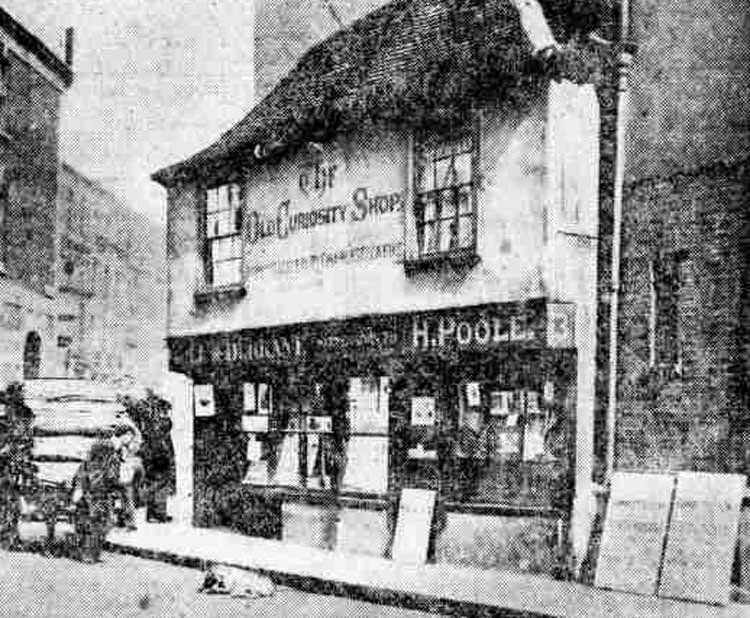
The Shop in May 1908.
By August, 1910, the shop was back in business and was doing a roaring trade selling all manner of curios and tat to eager visitors.
The Bystander, on Wednesday, 10th August 1910, enlightened its readers as to what those who visited the shop could expect to find inside:-
"This corner of London is, as everyone knows, saturated with reminiscences of Charles Dickens.
Just behind the Law Courts is a quaint little house which claims to be the "Old Curiosity Shop Immortalised by Charles Dickens." I believe there are differences of opinion as to the identity of the shop, but the present tenant takes the legend very seriously. He has a plaintive notice hanging on the wall of his shop in which he points out that, while he gets no allowance from the Government as custodian of such a remarkable heirloom, he is anxious to do his best to accommodate sightseers.
If you buy picture-post cards at the shop you are permitted to go upstairs into what the proprietor believes to be Little Nell's bedroom. If you don't buy postcards you are asked to pay threepence for the privilege in question.
When I got upstairs, I found a small room filled partly with lumber and partly with an American gentleman, his wife, and their daughter, a girl of about ten, who had apparently come some distance to see the room formerly occupied by Little Nell. The American gentleman expressed himself as rather disappointed with the room from a spectacular point of view. He hinted to me that he had expected to find a Dickens manuscript or two, and possibly a relic of Little Nell here and there. But there wasn't so much as a hairpin.
When we got downstairs and expressed our disappointment to the proprietor, that gentleman said he had done his best, but it really did not pay him to have people coming there to inspect the premises. If it does not pay a man to show you nothing for threepence, what is your own profit on the deal worked out to five decimal places I should rather like to have this gentleman's idea of a really remunerative enterprise.
I should also like to see the evidence on which this room is "believed to have been occupied by Little Nell." To begin with, as there never was any such person as Little Nell, she could not very well have had a bedroom. And then Dickens, in "The Old Curiosity Shop," expressly states that the bedroom of the child his brain had created was a kind of cupboard which was reached by a door that opened into it from the sitting-room behind the shop. And as "the little bed that a fairy might have slept in" was visible to those in the sitting-room, it could hardly have been located at the top of a narrow and winding staircase."
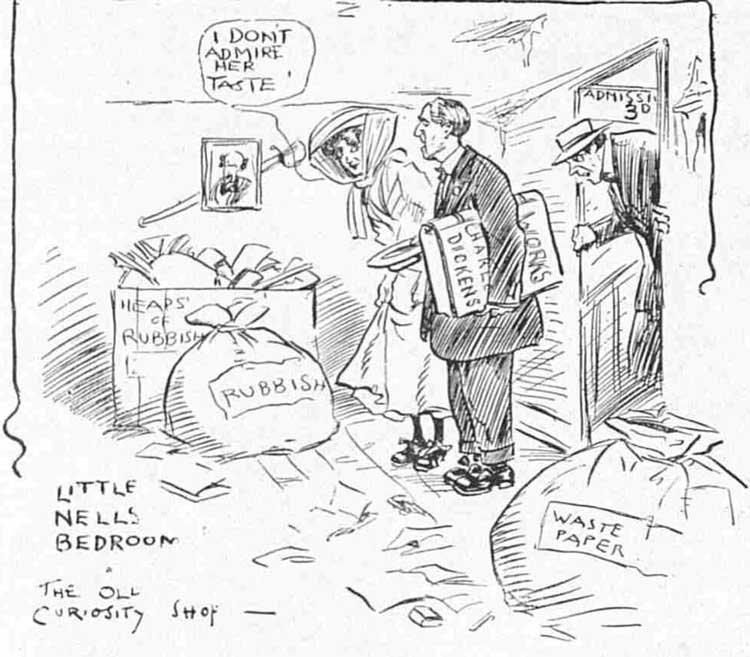
From The Bystander, Wednesday, 10th August, 1910
Copyright, The British Library Board.
In September 1910, Charles Dickens' eldest surviving son, Alfred D'Orsay Tennyson Dickens (1845 - 1912) arrived in England from Australia, to whence his father had encouraged him to emigrate in 1865, when Alfred's lavish lifestyle in London had resulted in his running up considerable debts.
He did fairly well in Australia and eventually settled in Melbourne where he was crippled financially when depression hit Victoria in the 1890s.
He began touring Australia giving lectures about his father's life and work, and these proved so successful that, in 1910, he decided to try his luck in Europe, and so returned to London for the first time in 45 years.
On arrival in London he set about exploring the locations across London that had been "immortalised" by his father, and paid a visit to "The Old Curiosity Shop", where a photographer from Tatler snapped him stepping out of the door looking exceptionally dapper.
It would appear that he was unwilling to follow the lead of other family members and scoff at the legend that this was the shop immortalised by his father, or at least if he did, none of the newspapers quoted him doing so.
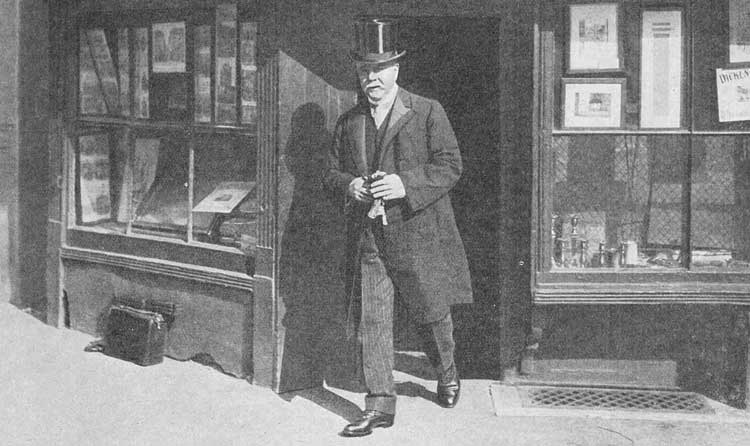
Alfred Tennyson Dickens leaving The Old Curiosity Shop.
From The Tatler, Wednesday, 5th October, 1910
Copyright, The British Library Board.
The Dundee Evening Telegraph, on Friday, 12th October 1923, reported that the shop had again changed hands:-
"The Old Curiosity Shop, in Portsmouth Street, Lincoln's Inn Fields. London, has changed hands.
Mr J. A. Phillips, of 123 Oxford Street, has purchased the quaint premises behind the Law Courts.
"I do not come into possession until early next year," said Mr Phillips, "and it is my intention to preserve the tradition and appearance of the shop as long as I am able. The shop is at present a repository for curios, and I intend to keep it as such. I want it to be a real old curiosity shop, and shall not destroy the associations of the place on any account."
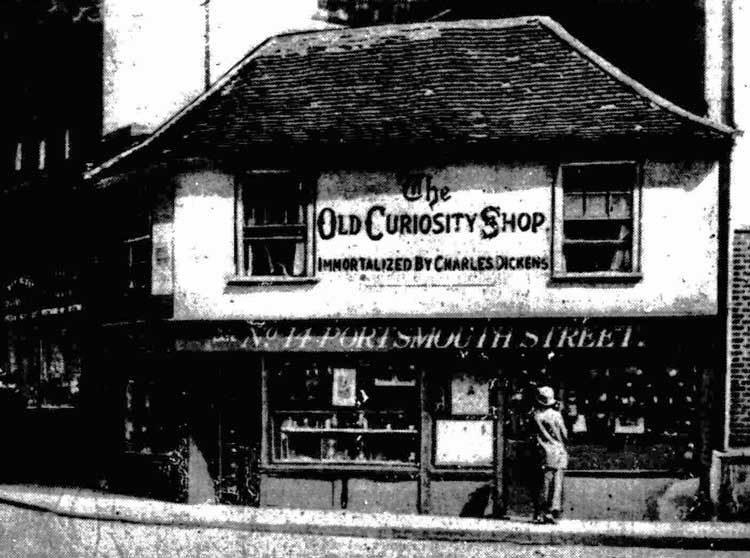
The Old Curiosity Shop In 1923.
Two years later, fate appears to have decided that it had been a while since it had waved its hand in the general direction of the old building, and, as The Portsmouth Evening News reported, on Thursday, 22nd January 1925, decided to have another bash at erasing the Dickensian impostor, this time by fire:-
"Just before ten o'clock last night the "Old Curiosity Shop," in Portsmouth Street, Lincoln's Inn Fields, was seen to be on fire. Smoke was issuing from one of the top windows, and fire engines were soon the scene.
The firemen discovered that the fire started in the right-hand upstairs room, in which, apparently, there had been a fire during the day.
A hose was run into the building, and the fire extinguished. Little damage was done.
The Old Curiosity Shop was bought in 1923 by Mr. J. A. Phillips, an estate agent of Oxford Street. It is now empty, with board outside offering it to be "let on lease."
The building has displayed the legend "The Old Curiosity Shop: Immortalised by Dickens" for nearly 50 years, and has been visited by thousands of sightseers, especially Americans.
Many doubt whether it is the building Dickens had in mind; some authorities asserting that the inscription was painted during the tenancy of a second-hand bookseller named Palmer."
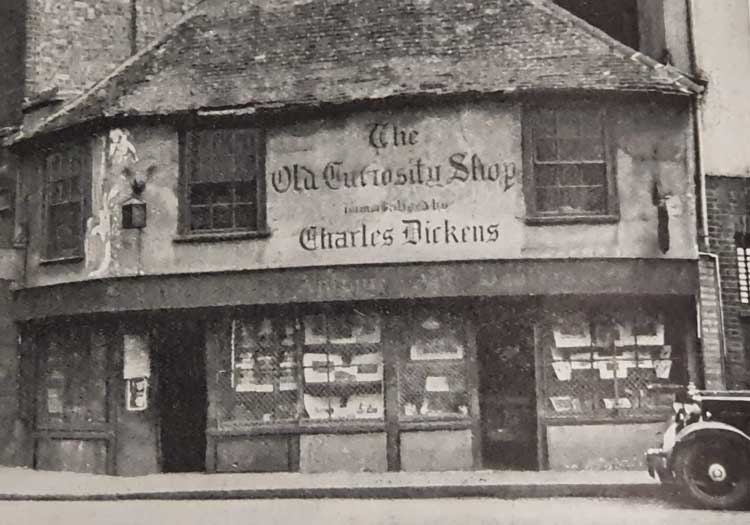
The Old Curiosity Shop In 1929.
By 1930, time, so it would seem, had not dealt kindly with The Old Curiosity Shop, and, as The Western Daily Press reported, on Tuesday, 14th October 1930, it was yet again condemned:-
"Fears for the safety of the Old Curiosity Shop, Portsmouth Street, London, immortalised by Charles Dickens, led to proceedings by the London County Council at Bow Street Police Court yesterday.
When the case was called on it was reported that the requirements of the Council had been carried out, and the summons was withdrawn."
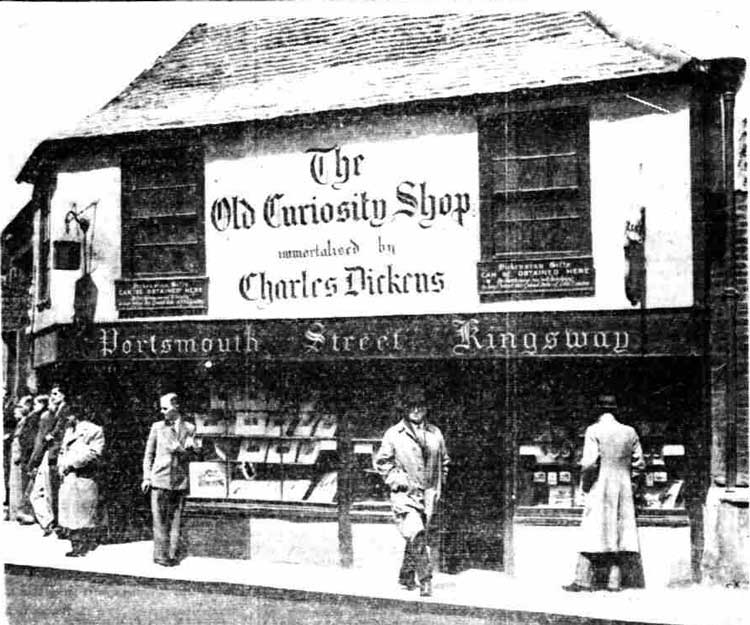
The Old Curiosity Shop In 1936.
The Illustrated Police News, on Thursday, 13th September 1934, published a story about a dastardly tour guide who had had the audacity to attempt to defraud the shop's then owner:-
"Stated to have posed as the organiser of a pilgrimage to Lourdes, Thomas Finnucane, 52, courier, Arlington Road, Camden Town, was sentenced by Mr. Ivan Snell, at the Marylebone Police Court, to a total of nine months' hard labour on charges stealing as a bailee [the theft of good by one who has been entrusted with them], at the Old Curiosity Shop, Portsmouth Street, Kingsway, a propelling pencil, worth twenty-five shillings, belonging to Mr. Bernard Lewis.
Detective-sergeant Denstead said that the accused, a man with a number of previous convictions for fraud and larceny, was lecturer, and had conducted a number of London tours. On one of these tours, he took a party to the Old Curiosity Shop in Portsmouth Street, and after they had gone he told Mr. Lewis that one of the party wished to buy a propelling pencil, worth twenty five shillings. The pencil was handed to him in trust, and he never returned it or paid for it."
Of course, when the Second World War broke out, and the bombs of the Blitz rained down on London, it was inevitable that The Old Curiosity Shop would come close to being destroyed.
Just how close can be seen from this article, which appeared The Sphere on Saturday, 5th April 1941:-
"During a recent raid "The Old Curiosity" Shop in Portsmouth Street, Kingsway, immortalised by Dickens and known throughout the world, was damaged by blast, and now, with the front shored up and cracks in its walls, it stands as a vivid reproach to Nazi vandalism, which seeks to destroy all that is traditional and beautiful to pave the way for the New Order!"
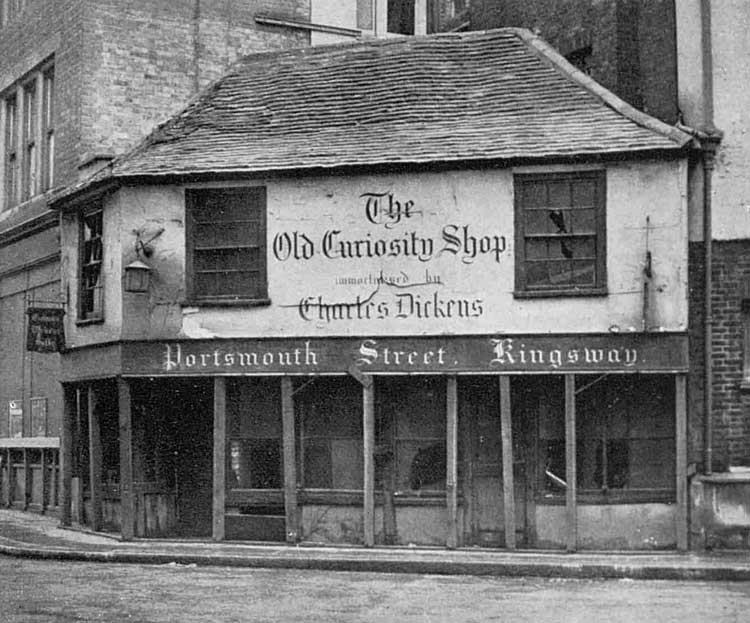
The building remained a curiosity shop throughout the post-war years, and was very popular with coach tours - passengers from which would arrive in steady streams throughout the day to peruse the wares and ponder its Dickensian connections.
Every so often , it would get a mention in the press, mostly to decry its claim to being the shop that Charles Dickens wrote about.
In 1988, it was put on the market, and, since 1992, it has been leased as a shop and work place by Japanese designer Daita Kimura who sells stunningly crafted handmade shoes, hats and various other sundries, some of which are even made on the premises.
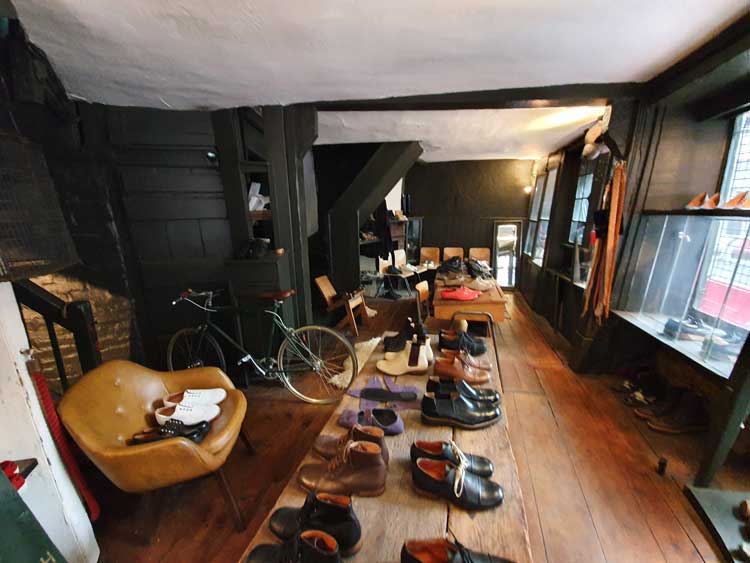
The interior of The Old Curiosity Shop January 2020.
For much of the last ten years the tiny little shop has been constantly surrounded by building sites, as the neighbouring London School of Economics continues its ever expanding expansion.
The shop has, at times, struck a forlorn figure, cowering beneath giant cranes and towering scaffolding, whilst heavy construction traffic rumbles by on the narrow street outside, sometimes shaking the very foundations of the little shop.
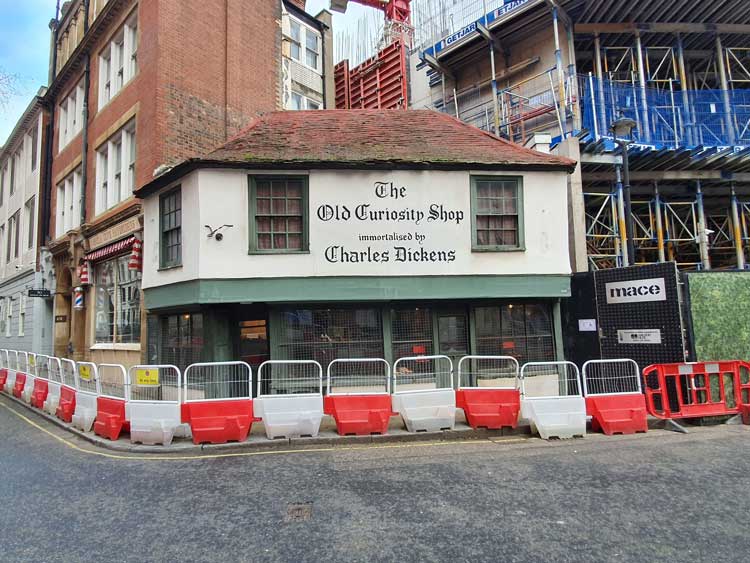
The Old Curiosity Shop January 2020.
But then, The Old Curiosity Shop has faced down threat after threat to its survival and it still stands, a true time capsule of bygone London.
And, do you know what?
It might not be the actual shop that was immortalized - and later immortalised - by Charles Dickens, but, with its ability to withstand all that time and progress has thrown at it, The Old Curiosity Shop has demonstrated time and again that, if nothing else, it is immortal.